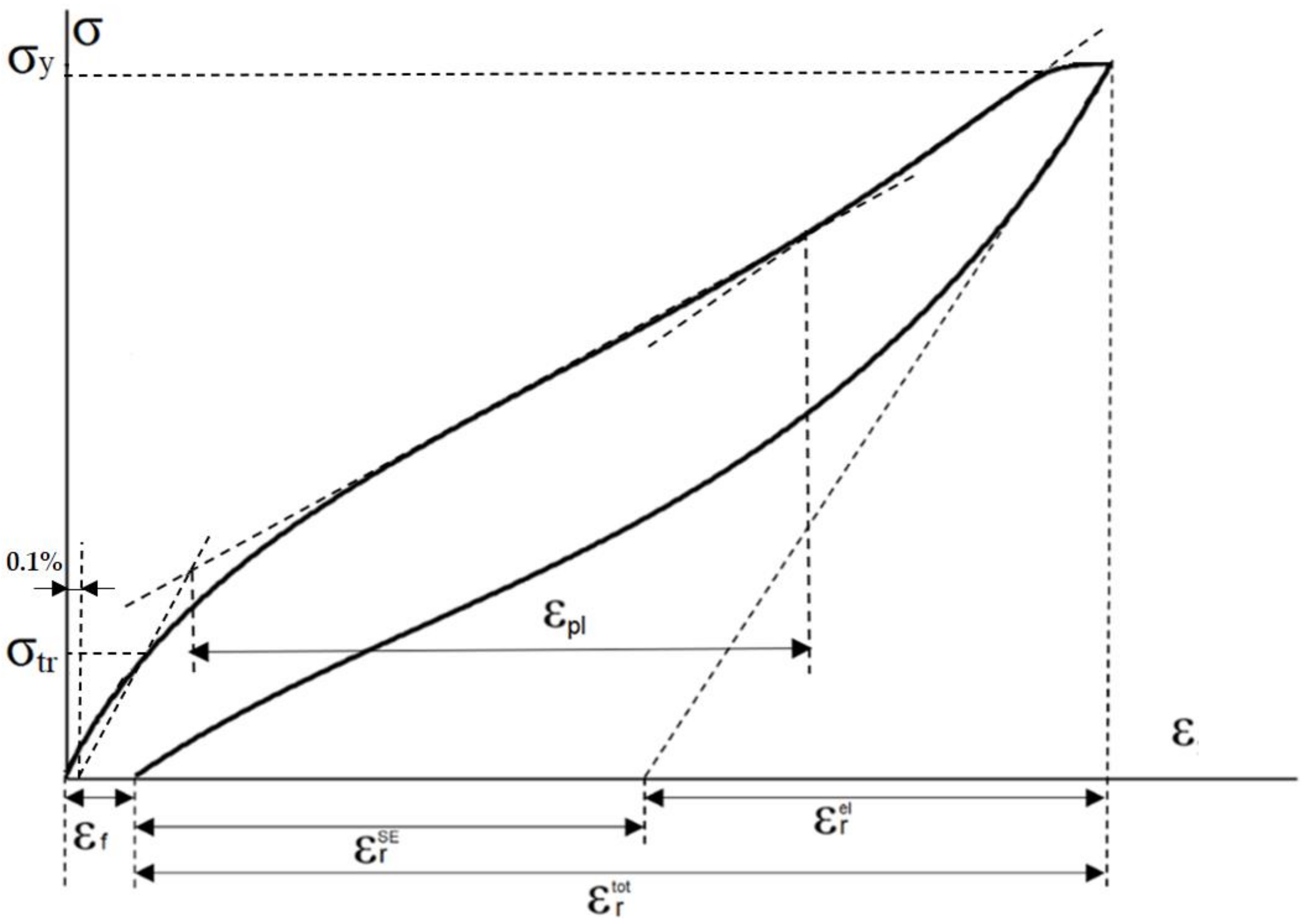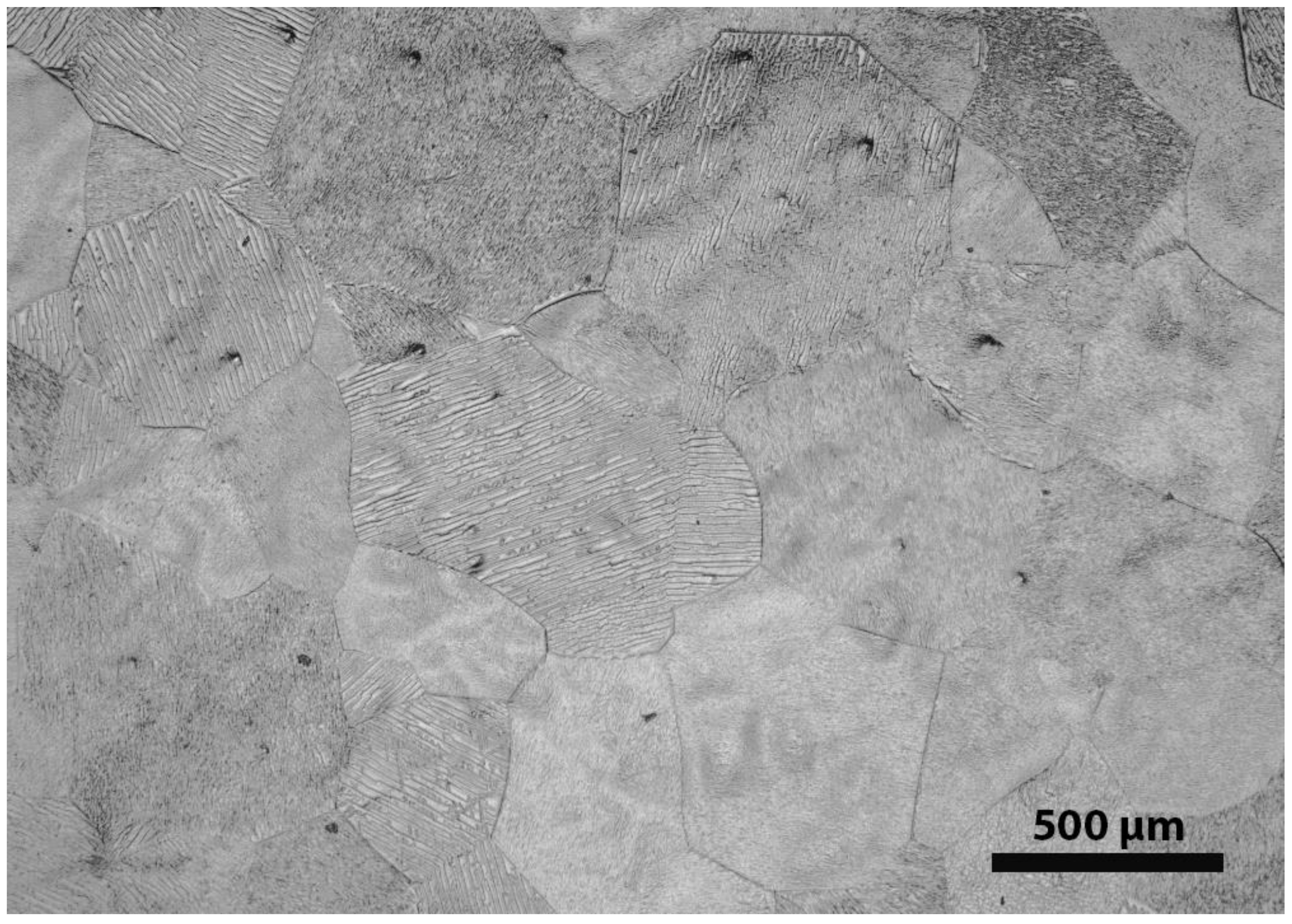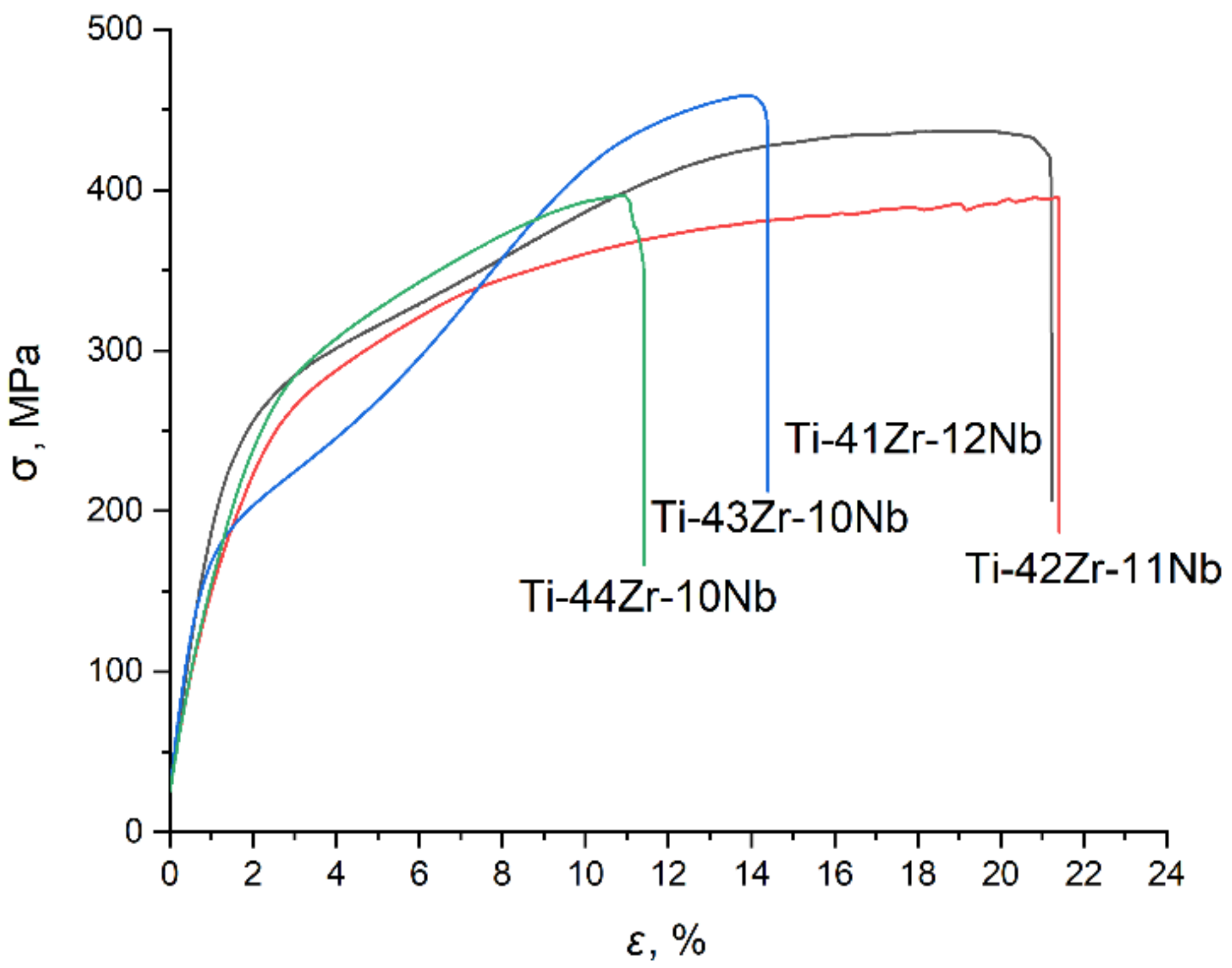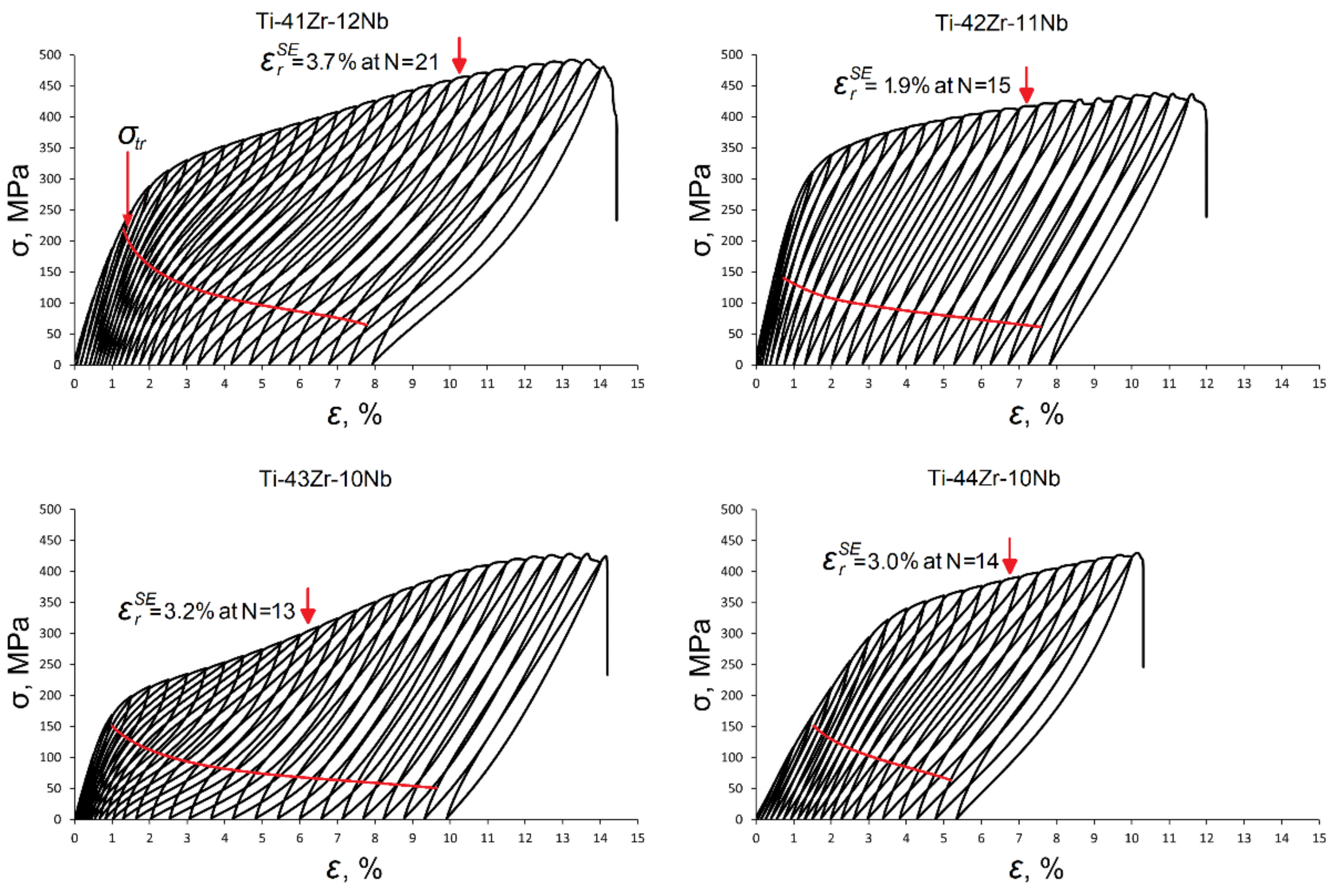Novel Zr-Rich Alloys of Ternary Ti-Zr-Nb System with Large Superelastic Recovery Strain
Abstract
:1. Introduction
2. Materials and Methods
2.1. Melting
2.2. Samples Preparation
2.3. Thermomechanical Treatment
2.4. Microstructure and Chemical Composition Studies
2.5. Mechanical Tests
3. Results and Discussion
3.1. Microstructure
3.2. Mechanical Tests
4. Conclusions
- All alloys subjected to an optimum thermomechanical treatment were in a high-temperature metastable β-phase state at room temperature. The microstructure of studied materials after TMT is characterized as mixed polygonized dislocation substructure and partially recrystallized grain structure. The absence of a noticeable amount of martensite phase indicates that the Ms temperature of all alloys is near or somewhat below RT.
- The theoretical recovery strain limits in the direction [011]β calculated from X-ray diffractograms are 5.9%, 6.3%, 7.5%, and 7.2% for Ti-41Zr-12Nb, Ti-42Zr-11Nb, Ti-43Zr-10Nb, and Ti-44Zr-10Nb, respectively. The differences in the calculated values are mainly associated with different Nb content in the studied alloys.
- UTS values of all studied alloys are near 400 MPa, and relative elongation value exceeds 20%, in the case of Ti-41Zr-12Nb and Ti-42Zr-11Nb, highlighting their enhanced ductility. Low microhardness values of about 200 HV0.2 confirms that all studied alloys are in a pre-martensitic state.
- All studied alloys demonstrate pronounced superelastic behavior at RT during mechanical testing. The superelastic recovery strains are 3.7%, 1.9%, 3.2%, and 3.0% for Ti-41Zr-12Nb, Ti-42Zr-11Nb, Ti-43Zr-10Nb, and Ti-44Zr-10Nb alloys, respectively. Such high superelastic recovery strain and total recovery strain over 6%, along with relative elongation to failure over 20%, allow us to consider the Ti-41Zr-12Nb alloy as one of the most promising superelastic alloys of the Ti-Zr-Nb system.
Supplementary Materials
Author Contributions
Funding
Institutional Review Board Statement
Informed Consent Statement
Data Availability Statement
Conflicts of Interest
References
- Machado, L.G.; Savi, M.A. Medical applications of shape memory alloys. Braz. J. Med. Biol. Res. 2003, 36, 683–691. [Google Scholar] [CrossRef] [PubMed]
- Cui, C.; Hu, B.; Zhao, L.; Liu, S. Titanium alloy production technology, market prospects and industry development. Mater. Des. 2011, 32, 1684–1691. [Google Scholar] [CrossRef]
- Murray, C.J.L.; Vos, T.; Lozano, R.; Naghavi, M.; Flaxman, A.D.; Michaud, C.; Ezzati, M.; Shibuya, K.; Salomon, J.A.; Abdalla, S.; et al. Disability-adjusted life years (DALYs) for 291 diseases and injuries in 21 regions, 1990–2010: A systematic analysis for the Global Burden of Disease Study 2010. Lancet 2012, 380, 2197–2223. [Google Scholar] [CrossRef]
- Stewart Williams, J.; Kowal, P.; Hestekin, H.; O’Driscoll, T.; Peltzer, K.; Yawson, A.; Biritwum, R.; Maximova, T.; Salinas Rodríguez, A.; Manrique Espinoza, B.; et al. Prevalence, risk factors and disability associated with fall-related injury in older adults in low- and middle-incomecountries: Results from the WHO Study on global AGEing and adult health (SAGE). BMC Med. 2015, 13, 147. [Google Scholar] [CrossRef] [PubMed] [Green Version]
- Rack, H.J.; Qazi, J.I. Titanium alloys for biomedical applications. Mater. Sci. Eng. C 2006, 26, 1269–1277. [Google Scholar] [CrossRef]
- Kurtz, S.; Ong, K.; Lau, E.; Mowat, F.; Halpern, M. Projections of Primary and Revision Hip and Knee Arthroplasty in the United States from 2005 to 2030. J. Bone Jt. Surg. 2007, 89, 780–785. [Google Scholar] [CrossRef]
- Carter, D.R.; Caler, W.E.; Spengler, D.M.; Frankel, V.H. Fatigue Behavior of Adult Cortical Bone: The Influence of Mean Strain and Strain Range. Acta Orthop. Scand. 1981, 52, 481–490. [Google Scholar] [CrossRef] [PubMed] [Green Version]
- Kuhn, J.L.; Goldstein, S.A.; Choi, R.; London, M.; Feldkamp, L.A.; Matthews, L.S. Comparison of the trabecular and cortical tissue moduli from human iliac crests. J. Orthop. Res. 1989, 7, 876–884. [Google Scholar] [CrossRef] [Green Version]
- Long, M.; Rack, H.J. Titanium alloys in total joint replacement—A materials science perspective. Biomaterials 1998, 19, 1621–1639. [Google Scholar] [CrossRef]
- Stohs, S. Oxidative mechanisms in the toxicity of metal ions. Free Radic. Biol. Med. 1995, 18, 321–336. [Google Scholar] [CrossRef] [Green Version]
- Sunderman, F.W., Jr. Carcinogenicity of metal alloys in orthopedic prostheses: Clinical and experimental studies. Fundam. Appl. Toxicol. 1989, 13, 205–216. [Google Scholar] [CrossRef]
- Yamamoto, A.; Honma, R.; Sumita, M. Cytotoxicity evaluation of 43 metal salts using murine fibroblasts and osteoblastic cells. J. Biomed. Mater. Res. 1998, 39, 331–340. [Google Scholar] [CrossRef]
- Hartwig, A. Carcinogenicity of metal compounds: Possible role of DNA repair inhibition. Toxicol. Lett. 1998, 102, 235–239. [Google Scholar] [CrossRef]
- Yamamoto, A.; Kohyama, Y.; Hanawa, T. Mutagenicity evaluation of forty-one metal salts by theumu test. J. Biomed. Mater. Res. 2002, 59, 176–183. [Google Scholar] [CrossRef]
- Beyersmann, D.; Hartwig, A. Carcinogenic metal compounds: Recent insight into molecular and cellular mechanisms. Arch. Toxicol. 2008, 82, 493–512. [Google Scholar] [CrossRef]
- Biesiekierski, A.; Wang, J.; Gepreel, M.A.-H.; Wen, C. A new look at biomedical Ti-based shape memory alloys. Acta Biomater. 2012, 8, 1661–1669. [Google Scholar] [CrossRef]
- Yoneyama, T.; Mayazaki, S. Shape Memory Alloys for Biomedical Applications; Woodhead Publishing: Sawston, UK, 2009; Available online: https://books.google.ru/books?id=MvqIvAEACAAJ (accessed on 5 April 2021).
- Zhukova, Y.S.; Pustov, Y.A.; Konopatsky, A.S.; Filonov, M.R. Characterization of electrochemical behavior and surface oxide films on superelastic biomedical Ti–Nb–Ta alloy in simulated physiological solutions. J. Alloys Compd. 2014, 586, S535–S538. [Google Scholar] [CrossRef]
- Zhukova Yu, S.; Pustov, Y.A.; Konopatsky, A.S.; Filonov, M.R.; Prokoshkin, S.D. Electrochemical Behavior of Novel Superelastic Biomedical Alloys in Simulated Physiological Media Under Cyclic Load. J. Mater. Eng. Perform. 2014, 23, 2677–2681. [Google Scholar] [CrossRef]
- Konopatsky, A.S.; Dubinskiy, S.M.; Zhukova, Y.S.; Sheremetyev, V.; Brailovski, V.; Prokoshkin, S.D.; Filonov, M.R. Ternary Ti-Zr-Nb and quaternary Ti-Zr-Nb-Ta shape memory alloys for biomedical applications: Structural features and cyclic mechanical properties. Mater. Sci. Eng. A 2017, 702, 301–311. [Google Scholar] [CrossRef]
- Peter, I. Investigations into Ti-Based Metallic Alloys for Biomedical Purposes. Metals 2021, 11, 1626. [Google Scholar] [CrossRef]
- Arias-González, F.; Rodríguez-Contreras, A.; Punset, M.; Manero, J.M.; Barro, Ó.; Fernández-Arias, M.; Lusquiños, F.; Gil, F.J.; Pou, J. In-Situ Laser Directed Energy Deposition of Biomedical Ti-Nb and Ti-Zr-Nb Alloys from Elemental Powders. Metals 2021, 11, 1205. [Google Scholar] [CrossRef]
- Li, Y.; Cui, Y.; Zhang, F.; Xu, H. Shape memory behavior in Ti–Zr alloys. Scr. Mater. 2011, 64, 584–587. [Google Scholar] [CrossRef]
- Kim, H.Y.; Fu, J.; Tobe, H.; Kim, J.; Miyazaki, S. Crystal Structure, Transformation Strain, and Superelastic Property of Ti–Nb–Zr and Ti–Nb–Ta Alloys. Shape Mem. Superelasticity 2015, 1, 107–116. [Google Scholar] [CrossRef] [Green Version]
- Qu, W.; Sun, X.; Yuan, B.; Xiong, C.; Zhang, F.; Li, Y.; Sun, B. Microstructures and phase transformations of Ti-30Zr-xNb (x = 5, 7, 9, 13 at.%) shape memory alloys. Mater. Charact. 2016, 122, 1–5. [Google Scholar] [CrossRef]
- Konopatsky, A.; Sheremetyev, V.; Dubinskiy, S.; Zhukova, Y.; Firestein, K.; Golberg, D.; Filonov, M.; Prokoshkin, S.; Brailovski, V. Structure and Superelasticity of Novel Zr-Rich Ti-Zr–Nb Shape Memory Alloys. Shape Mem. Superelasticity 2021, 7, 304–313. [Google Scholar] [CrossRef]
- Fu, J.; Yamamoto, A.; Kim, H.Y.; Hosoda, H.; Miyazaki, S. Novel Ti-base superelastic alloys with large recovery strain and excellent biocompatibility. Acta Biomater. 2015, 17, 56–67. [Google Scholar] [CrossRef]
- Li, S.; Choi, M.; Nam, T. Role of fine nano-scaled isothermal omega phase on the mechanical and superelastic properties of a high Zr-containing Ti–Zr–Nb–Sn shape memory alloy. Mater. Sci. Eng. A 2020, 782, 139278. [Google Scholar] [CrossRef]
- Li, S.; Nam, T. Superelasticity and tensile strength of Ti-Zr-Nb-Sn alloys with high Zr content for biomedical applications. Intermetallics 2019, 112, 106545. [Google Scholar] [CrossRef]
- Zhukova, Y.S.; Petrzhik, M.I.; Prokoshkin, S.D. Estimation of the crystallographic strain limit during the reversible β ⇄ α″ martensitic transformation in titanium shape memory alloys. Russ. Metall. 2010, 2010, 1056–1062. [Google Scholar] [CrossRef]
- Kim, H.Y.; Miyazaki, S. Martensitic Transformation and Superelastic Properties of Ti-Nb Base Alloys. Mater. Trans. 2015, 56, 625–634. [Google Scholar] [CrossRef] [Green Version]
- Brailovski, V.; Prokoshkin, S.; Terriault, P.; Trochu, F. (Eds.) Shape Memory Effects: Shape Memory Alloys: Fundamentals, Modeling and Applications; ETS Publications: Montreal, QC, Canada, 2003; pp. 115–130. Available online: https://books.google.ru/books?id=CP_6PQAACAAJ (accessed on 22 March 2021).
- Fu, J.; Kim, H.Y.; Miyazaki, S. Effect of annealing temperature on microstructure and superelastic properties of a Ti-18Zr-4.5Nb-3Sn-2Mo alloy. J. Mech. Behav. Biomed. Mater. 2017, 65, 716–723. [Google Scholar] [CrossRef] [PubMed]
- Pavón, L.L.; Cuellar, E.L.; Hernandez, S.V.; Moreno-Cortez, I.E.; Kim, H.Y.; Miyazaki, S. Effect of heat treatment condition on microstructure and superelastic properties of Ti24Zr10Nb2Sn. J. Alloys Compd. 2019, 782, 893–898. [Google Scholar] [CrossRef]








| Alloys | O, % | N, % | C, % | S, % | H, % |
|---|---|---|---|---|---|
| 41–12 | 0.17 ± 0.002 | <0.001 | 0.030 ± 0.002 | <0.001 | 0.004 ± 0.0004 |
| 42–11 | 0.21 ± 0.002 | <0.001 | 0.037 ± 0.002 | <0.001 | 0.009 ± 0.0004 |
| 43–10 | 0.17 ± 0.002 | <0.001 | 0.025 ± 0.002 | <0.001 | 0.008 ± 0.0004 |
| 44–10 | 0.18 ± 0.002 | <0.001 | 0.033 ± 0.002 | <0.001 | 0.004 ± 0.0004 |
| Alloys | ε [011], % | ||
|---|---|---|---|
| 41–12 | 0.5149 | 0.4848 | 5.9 ± 1.0 |
| 42–11 | 0.5163 | 0.4852 | 6.3 ± 1.0 |
| 43–10 | 0.5213 | 0.4846 | 7.5 ± 0.2 |
| 44–10 | 0.5214 | 0.4858 | 7.2 ± 0.2 |
| Alloys | UTS, MPa | εpl, % | δ, % | Hardness, HV 0.2 | |||
|---|---|---|---|---|---|---|---|
| 41–12 | 435 | 266 | — | 416 | 6.0 | 22.4 | 206 ± 11 |
| 42–11 | 395 | — | 262 | — | n/a | 23.5 | 231 ± 7 |
| 43–10 | 458 | 171 | — | 403 | 4.7 | 14.4 | 232 ± 12 |
| 44–10 | 396 | — | 266 | — | n/a | 11.4 | 217 ± 7 |
Publisher’s Note: MDPI stays neutral with regard to jurisdictional claims in published maps and institutional affiliations. |
© 2022 by the authors. Licensee MDPI, Basel, Switzerland. This article is an open access article distributed under the terms and conditions of the Creative Commons Attribution (CC BY) license (https://creativecommons.org/licenses/by/4.0/).
Share and Cite
Barilyuk, D.; Bazlov, A.; Arkharova, N.; Teplyakova, T.; Konopatsky, A.; Prokoshkin, S. Novel Zr-Rich Alloys of Ternary Ti-Zr-Nb System with Large Superelastic Recovery Strain. Metals 2022, 12, 185. https://doi.org/10.3390/met12020185
Barilyuk D, Bazlov A, Arkharova N, Teplyakova T, Konopatsky A, Prokoshkin S. Novel Zr-Rich Alloys of Ternary Ti-Zr-Nb System with Large Superelastic Recovery Strain. Metals. 2022; 12(2):185. https://doi.org/10.3390/met12020185
Chicago/Turabian StyleBarilyuk, Danil, Andrey Bazlov, Natalia Arkharova, Tatyana Teplyakova, Anton Konopatsky, and Sergey Prokoshkin. 2022. "Novel Zr-Rich Alloys of Ternary Ti-Zr-Nb System with Large Superelastic Recovery Strain" Metals 12, no. 2: 185. https://doi.org/10.3390/met12020185
APA StyleBarilyuk, D., Bazlov, A., Arkharova, N., Teplyakova, T., Konopatsky, A., & Prokoshkin, S. (2022). Novel Zr-Rich Alloys of Ternary Ti-Zr-Nb System with Large Superelastic Recovery Strain. Metals, 12(2), 185. https://doi.org/10.3390/met12020185







